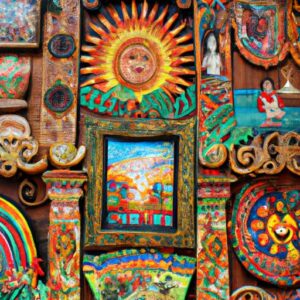France, a country renowned for its rich artistic heritage, has long captivated the world with its vibrant and diverse traditional art forms. From the exquisite paintings that adorn the walls of renowned museums to the awe-inspiring sculptures that grace public spaces, traditional art in france is a treasure trove of beauty and cultural significance. In this article, we will embark on a journey to explore the captivating world of traditional art in France, delving into its history, importance, and its indelible mark on French culture.
Importance and Significance of Traditional Art in French Culture
Traditional art holds a special place in French culture, serving as a testament to the nation’s artistic prowess and its deep-rooted heritage. It embodies the essence of French identity, allowing us to connect with the past and appreciate the craftsmanship that has shaped the cultural landscape of the country. From the intricate brushstrokes of iconic paintings to the intricately carved sculptures, traditional art serves as a visual representation of the French spirit, capturing the emotions, values, and aspirations of its people.
A Brief History of Traditional Art in France
The history of traditional art in France is a tapestry woven with centuries of artistic achievements. Dating back to the prehistoric era, cave paintings found in regions like Lascaux provide a glimpse into the artistic expressions of early French civilizations. As time progressed, art forms such as Romanesque and Gothic architecture, illuminated manuscripts, and tapestries flourished. The Renaissance period witnessed the emergence of renowned French painters like Leonardo da Vinci and Claude Monet, further enriching the artistic heritage of the nation. From the Romanticism of Eugène Delacroix to the Impressionism of Pierre-Auguste Renoir, each era brought forth its own unique artistic movements, cementing France as a powerhouse in the world of traditional art.
As we embark on this journey through the realms of traditional art in France, let us delve deeper into the enchanting world of painting, sculpture, architecture, pottery, textiles, and the profound influence of traditional art on French culture. Join me as we unravel the secrets and beauty of traditional art in France, celebrating the timeless masterpieces that continue to inspire and enchant us to this day.
Traditional Art Forms in France
Painting: A Canvas of French Artistry
French painting has left an indelible mark on the world of art, with renowned painters who have shaped the course of traditional art. From the iconic brushstrokes of Leonardo da Vinci’s “Mona Lisa” to the vibrant Impressionist works of Claude Monet, French painters have mastered the art of capturing emotions, landscapes, and the essence of life itself. Their contributions to traditional art have not only influenced generations of artists but have also become an integral part of France’s cultural identity.
Sculpture: Carving the Path of French Excellence
French sculptors have breathed life into stone, metal, and clay, creating masterpieces that transcend time. Notable sculptors like Auguste Rodin, whose “The Thinker” has become an emblem of deep contemplation, have pushed the boundaries of artistic expression. Their exquisite craftsmanship and attention to detail have brought forth sculptures that evoke powerful emotions and leave a lasting impression on all who behold them.
Architecture: The Grandeur of French Design
French architecture is a testament to the country’s rich history and innovative design. From the medieval marvels of Notre-Dame Cathedral to the opulence of the Palace of Versailles, each architectural style tells a story of the era it represents. The Gothic, Renaissance, and Baroque styles have left an indelible mark on the landscape of France, showcasing the country’s commitment to architectural excellence and artistic vision.
Pottery: A Celebration of French Craftsmanship
Traditional pottery techniques in France have been passed down through generations, resulting in exquisite pieces of functional and decorative art. From the elegant porcelain of Limoges to the rustic earthenware of Provence, French pottery artists have honed their skills to create pieces that reflect the beauty of the French countryside and the mastery of their craft. The delicate artistry and intricate designs of French pottery continue to captivate art enthusiasts worldwide.
Textiles: Weaving Stories of French Tradition
Traditional French textile art, including tapestry and embroidery, showcases the country’s rich heritage and attention to detail. From the intricate tapestries of the Gobelins Manufactory to the delicate embroidery of haute couture fashion, French textile artists have mastered the art of storytelling through fabric. Each stitch and thread tells a tale of French history, culture, and craftsmanship, ensuring that this traditional art form remains an integral part of the French artistic landscape.
Join me as we delve deeper into each of these traditional art forms, uncovering the masterpieces and the artists who have shaped the artistic legacy of France. Together, we will celebrate the beauty and significance of traditional art in France, a testament to the country’s artistic prowess and cultural heritage.
Influence of Traditional Art on French Culture
Traditional art in France not only serves as a source of aesthetic pleasure but also plays a profound role in shaping the cultural fabric of the nation. Let us explore the significant impact of traditional art on French identity, its influence on contemporary art and design, and its crucial role in preserving and promoting French heritage.
Impact of Traditional Art on French Identity and National Pride
Traditional art forms are deeply intertwined with the notion of French identity, acting as a mirror that reflects the values, history, and collective memory of the nation. From the majestic landscapes depicted in Impressionist paintings to the grandeur of Gothic cathedrals, traditional art encapsulates the essence of France, evoking a sense of pride and belonging among its people. It serves as a visual representation of the cultural heritage that has shaped the French nation, instilling a shared sense of identity and fostering a deep connection with the past.
Influence of Traditional Art on Contemporary French Art and Design
The influence of traditional art extends beyond the realms of the past, permeating into contemporary French art and design. Artists and designers draw inspiration from traditional art forms, infusing them with modern interpretations to create unique and innovative works. The fusion of old and new breathes new life into traditional art, ensuring its relevance and continuous evolution in the ever-changing artistic landscape.
From fashion to interior design, traditional art acts as a wellspring of inspiration, influencing the aesthetics, techniques, and motifs employed in contemporary creations. Whether it is the incorporation of intricate tapestry patterns in textile design or the adaptation of classical architectural elements in modern buildings, traditional art forms provide a rich source of inspiration that transcends time and bridges the gap between the old and the new.
Role of Traditional Art in Preserving and Promoting French Heritage
Traditional art serves as a guardian of French heritage, playing a vital role in preserving and promoting the cultural legacy of the nation. Museums and galleries showcase masterpieces from various periods, allowing visitors to immerse themselves in the rich tapestry of French art history. Through exhibitions and educational programs, traditional art is kept alive, fostering a deeper understanding and appreciation for the artistic achievements of the past.
Furthermore, traditional art festivals and events celebrate the diverse range of art forms, showcasing the talents of local artists and artisans. These cultural festivities not only provide a platform for artists to showcase their work but also create opportunities for the wider community to engage with traditional art, ensuring its continued relevance and vitality.
In conclusion, traditional art in France has a profound influence on French culture. It shapes the nation’s identity, inspires contemporary art and design, and serves as a guardian of French heritage. Through its impact and role, traditional art continues to captivate and enchant, preserving the artistic legacy of the past while shaping the artistic landscape of the future.
Traditional Art Festivals and Events in France
Overview of Popular Traditional Art Festivals and Events
In France, traditional art festivals and events offer a vibrant celebration of the nation’s artistic heritage, bringing together artists, enthusiasts, and locals in a harmonious display of cultural richness. These festivals serve as a platform for artists to showcase their talents while preserving and promoting traditional art forms. Let’s explore some of the most renowned traditional art festivals and events that adorn the French calendar.
A Glimpse into Selected Festivals: History and Significance
1. Festival d’Avignon – Celebrating Performing Arts
The Festival d’Avignon, held annually in the historical city of Avignon, is a prestigious event that celebrates the performing arts. Established in 1947, it showcases a wide range of traditional art forms such as theater, dance, music, and puppetry. This festival not only presents renowned international artists but also provides a platform for emerging talents, fostering creativity and artistic exchange.
2. Fête de la Musique – Melodies that Echo through the Streets
The Fête de la Musique, celebrated on June 21st every year, is a nationwide musical extravaganza that engulfs the streets of France. This event encourages musicians of all genres and skill levels to perform in public spaces, transforming the entire country into a stage. From classical symphonies to contemporary rock bands, these diverse musical performances create an enchanting atmosphere, captivating both locals and tourists alike.
Participation and Involvement of Local Communities and Artists
Traditional art festivals and events in France thrive on the active participation and involvement of local communities and artists. These events provide a platform for artists to showcase their skills, fostering a sense of pride and appreciation for their cultural heritage. Local communities actively contribute by organizing and hosting these festivals, ensuring their continuity and success. The presence of artists in these events not only enriches the cultural experience but also allows for the passing down of traditional skills and knowledge to future generations.
As we explore the traditional art festivals and events in France, we witness the fusion of creativity, culture, and community spirit. These celebrations showcase the diverse traditional art forms that have shaped French culture, providing a vibrant platform for artists to share their talents and for audiences to immerse themselves in the beauty of traditional art. Join me as we continue our journey through the enchanting world of traditional art in France.
Traditional Art Museums and Galleries in France
France’s love for traditional art is beautifully showcased in its renowned museums and galleries, which serve as custodians of the country’s rich cultural heritage. These institutions not only preserve and protect traditional art but also provide a platform for artists to display their masterpieces to a global audience. Let’s explore some of the most prominent museums and galleries that celebrate the beauty of traditional art in France.
Musée du Louvre
One cannot discuss traditional art in France without mentioning the iconic Musée du Louvre. Located in Paris, this world-famous museum houses an extensive collection of traditional art, featuring masterpieces from various periods and styles. From Leonardo da Vinci’s enigmatic Mona Lisa to the majestic Venus de Milo, the Louvre offers an immersive experience into the world of traditional art, captivating visitors from around the globe.
Musée d’Orsay
Situated in a former railway station in Paris, the Musée d’Orsay is a treasure trove of Impressionist and Post-Impressionist art. It boasts an impressive collection of traditional art, including works by Monet, Renoir, Van Gogh, and Degas. The museum’s elegant setting and exceptional curation make it a must-visit for art enthusiasts seeking to immerse themselves in the beauty of traditional art.
Musée Rodin
Dedicated to the works of the legendary French sculptor Auguste Rodin, the Musée Rodin in Paris offers a glimpse into the world of sculptural art. The museum’s serene gardens are adorned with some of Rodin’s most famous sculptures, including “The Thinker” and “The Kiss.” This institution not only showcases Rodin’s brilliance but also pays homage to the art of sculpture, showcasing its significance in French culture.
These museums and galleries play a vital role in preserving and promoting traditional art in France. They provide a platform for artists to showcase their talent, educate the public about the cultural heritage of the country, and inspire future generations to appreciate and create traditional art. Through their exhibitions, collections, and educational initiatives, these institutions contribute to the continued vibrancy and relevance of traditional art in France.
Future of Traditional Art in France: Embracing Modernity While Preserving Heritage
As we stand at the crossroads of modernity and tradition, the future of traditional art in France holds both challenges and opportunities. In an era dominated by digital advancements and evolving artistic trends, the preservation and promotion of traditional art forms become paramount. How can we ensure that the rich cultural heritage of traditional art in France continues to thrive and evolve?
Challenges Faced by Traditional Art
One of the primary challenges is the dwindling number of artists who specialize in traditional art forms. As younger generations gravitate towards contemporary art, traditional techniques risk being lost to time. Additionally, the demand for instant gratification and mass-produced art creates a barrier for the slow, meticulous nature of traditional art creation. The digital age has also ushered in new mediums and platforms, leading to the question of relevance and adaptability for traditional art forms.
Reviving Traditional Art: Efforts and Initiatives
Thankfully, numerous efforts are underway to support and revive traditional art in France. Art organizations, educational institutions, and passionate individuals are working tirelessly to preserve the techniques and knowledge handed down through generations. They offer workshops, apprenticeships, and mentorship programs to bridge the gap between established artists and emerging talents, ensuring the continuity of traditional art forms.
Furthermore, collaborations between traditional and contemporary artists are breathing new life into traditional art. By exploring innovative mediums, techniques, and themes, artists are finding ways to infuse traditional art with a modern twist, captivating the interest of a wider audience.
The Evolution of Traditional Art
While preserving tradition is crucial, the future of traditional art in France lies in embracing modernity. By adapting to the changing times, traditional art can find its place in contemporary society. Artists are incorporating elements of technology, exploring new materials, and engaging with diverse communities to keep traditional art relevant and accessible.
Opportunities on the Horizon
The future of traditional art in France holds immense potential. As the world becomes more interconnected, there is a growing appreciation for cultural diversity and heritage. Traditional art forms offer a unique lens into French culture, allowing for cross-cultural exchanges and collaborations. With increasing tourism and the rise of digital platforms, traditional art in France can reach global audiences, fostering a deeper understanding and appreciation for the country’s artistic legacy.
In conclusion, while traditional art in France faces its fair share of challenges, it continues to evolve, adapt, and inspire. By nurturing emerging talents, embracing modernity, and celebrating the rich heritage, traditional art can transcend time, ensuring its enduring presence in the artistic landscape of France and the world. Let us embrace the future while cherishing the beauty of the past, for traditional art in France is a testament to the timeless and universal power of artistic expression.





